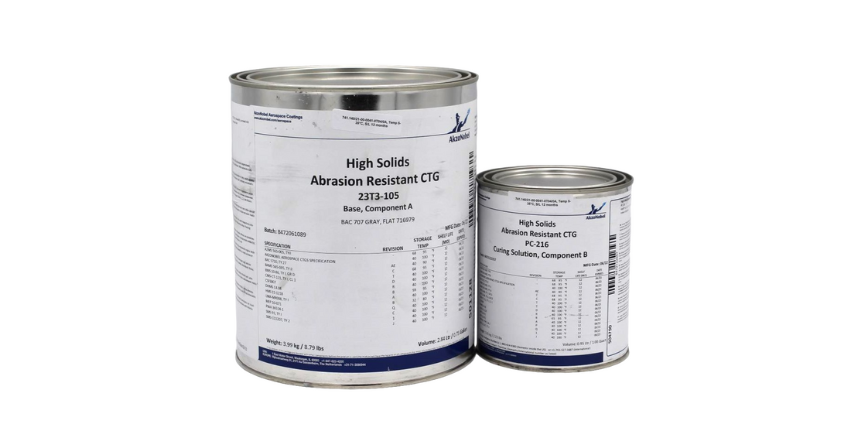It can take up to two weeks of labor and perhaps more than a thousand gallons of paint to paint an airplane. While coatings undoubtedly play a key part in cosmetic improvement, their primary function is to guard against corrosion and enhance the aerodynamics of the aircraft.
An airplane has to go through a fresh coating phase roughly every five to seven years in order to be able to keep soaring safely. In order to get the best results in terms of both aesthetics and, more importantly, efficiency and safety, painting an airplane is a difficult, precise, multi-step procedure that must be executed to perfection.
It is very important to choose the right paint for an aircraft due to various reasons including compatibility to aircraft materials, durability, cost and many other factors [1].
Figure 1 – Aircraft Painting [1]

Types of aircraft paints
There are four main types of paints that are used for aircraft coating. They are listed with illustration of each one’s advantages and drawbacks.
Polyurethane Paints
An aerospace-grade, multi-component aviation paint that is chemically cured and generates a surface that is resistant to chemicals, solvents, and abrasion is known as polyurethane coating. An example is PPG CA 8000 B707-KCH0 Desothane HS Topcoat. This coating is suggested for high duty industrial applications where a robust, durable finish is required since it has great adherence to the majority of substrates.
Due to its unique combination of qualities, including component, liquid, cured coating, resistance, mixing, application, cleanability, and strip ability, it is regarded as the best airplane coating [1].
The main disadvantage of this type of painting is that it would need a costly, sufficiently large, and well-kept painting room or hangar.
Epoxy Paints
Epoxy paints are two-part coatings that were created to give a solution on metal surfaces. An example is Akzo Nobel Mapaero F69 Finish in Red. The method typically employs a 3:1 by volume mixing ratio and dries overnight to provide a hard, protective coating with exceptional hardness.
Epoxy adhesives' extraordinary strength-achieving capabilities are one of its main benefits. In comparison to other chemical types like acrylics or polyurethanes, some formulations might be considerably stronger. Because they may be used to join a variety of materials, such as metal, wood, glass, and other types of plastics, epoxy adhesives are also incredibly adaptable.
Additionally, epoxy adhesives frequently offer excellent temperature and chemical resistance. This implies that an epoxy glue is the ideal option if the adhesive will be exposed to chemicals (such as when used in a gasoline tank), as such chemicals won't harm the bond's integrity.
Epoxy adhesives often have a lengthy cure time, which is one of its main drawbacks. Usually, it takes many hours or even days for epoxy adhesives to fully cure. Epoxy adhesives may potentially provide concerns to one's health and safety. There are several compounds in epoxy adhesives that might be dangerous to handle. Epoxy adhesives' requirement for surface preparation is another drawback [3].
Acrylic Paints
Acrylic paint is formed of pigment suspended in an imitation of acrylic. It quickly dries, is water-soluble, and after drying, becomes water-resistant
Since acrylic paints are water-based, they offer the benefit of being low in toxicity. Another benefit is that they dry quickly, eliminating the need to wait for layers to dry in between painting sessions. Furthermore, it has been demonstrated that acrylic paints are more flexible than oil paints. Acrylics won't break if you don't go by the "fat over lean" criteria.
One drawback of acrylic paints is that they are difficult to combine in order to use the "wet in wet" approach that is used with oil paints. Additionally, paint cannot be removed or changed once it has dried [4].
Enamel Paints
A form of paint made specifically for use on airplanes and other aircraft is called enamel aircraft paint. Because it hardens, it varies from other kinds of paint. An engine of an airplane that has been painted with enamel aircraft paint will start to cure after application. The corresponding engine will develop a firm shell after the enamel aviation paint has fully dried.
Heat resistance is the primary benefit of enamel aviation paint. Other forms of paint may swiftly deteriorate when exposed to the heat of an airplane engine. However, enamel aviation paint provides a higher level of heat resistance. It won't chip, flake, or otherwise degrade under the intense heat of an airplane engine. They are also air-cured, no need for additional materials for the curing process.
Check Out:
Aerospheres Wide Range of Aircraft Paints
Bonding the Skies: A Practical Guide to Choosing and Using Aerospace Adhesives
Smooth Operations: Navigating the World of Aviation Lubricants
Flying High with Composites: Your Essential Guide to Aircraft Composites
The Essential Guide to Aircraft Sealants
Factors to Consider when Choosing Aircraft Paint
There are numerous factors to consider in order to choose the right paint for an aircraft, including durability, resistance, weight, application time, drying time and color options.
Durability & Resistance
The chosen aircraft paint must satisfy the requirement of its application. Some paints are applied in areas where it can exhibit extreme temperature changes, like very high temperatures in and around the engine areas, and very cold temperatures on the aircraft skin specially at the nose area.
Some other areas will be subjected to high Ultraviolet rays, which can rapid the paint degradation if not kept in mind, so, in some applications, resistance to UV rays must be considered while choosing the paint. Some areas of the aircraft also may be exposed to chemical contamination, like the areas close to lubricated mechanisms, or in the interior of the aircraft where liquids can be spilled anytime, choosing adequate paint that offer high resistance to chemical contamination is desirable in these areas.
Aircraft paint type to choose must propose the required durability while maintaining high resistance to the operation environment, and that is why Epoxy paints are widely used in various parts of the aircraft due to its high chemical and temperature resistance.
Weight Considerations
Another crucial factor in the aircraft industry is the weight. Given the size of the surfaces, even though the paint layer is typically thin, it can add up to 550 kg to the weight of an aircraft, which will in consequence lead to higher fuel consumption and higher operational cost. So, it is very important to choose light weighted painting options in the aircraft industry.
Enamel paints and Epoxy paints offer the lightweight paint option for the aircraft coating. The color picked also affects the weight of the airplane; the heavier the aircraft, the more fuel it will consume and the less money the airline will make.
Application and drying time
Because aircraft downtime is a very costly operation in the aviation industry, the application and drying time of aircraft paint is very important. Any paint needs time to be applied based on the number of layers and bonding; application of some paints is not easy due to the usage of more than one material and mixing them with a predefined ratio. Also, cure time is essential for the paint to dry before the aircraft can continue operation. Application and drying time differ from one paint to another.
Color options and customization
Paint schemes applied on aircraft body to achieve the required livery is also critical to the choice of the paint type. Types of paints that are applied easily must be chosen for the more complex painting schemes. Some paint types offer the ease to customize the color by offering variation of the mixing color ability; some paint types offer two color mixing customization, other offer three color mixing customization, and depending on the required scheme, the right paint should be chosen.
Compatibility with Aircraft Materials
Not all paint types are compatible with all materials, that is why understanding the compatibility with the materials is essential before using the paint type. Also, repair of damaged and deteriorating regions is particularly challenging due to the employment of numerous distinct types of paint and several unique finishes. The different paint treatments are not always compatible with one another. For example, to bare metal and both nitrocellulose and epoxy finishes, acrylic nitrocellulose lacquers adhere poorly [5].
Importance of complying with aviation regulations
The Federal Aviation Administration (FAA) has put in place rules that control how airplanes are painted. The rules are designed to prevent the paint from hiding any crucial insignia or impairing the performance of the aircraft, first and foremost. The correct paint must be used, and it's crucial to carefully follow the manufacturer's directions. Since certain paints are not intended for use on airplanes, choosing the incorrect one might harm the plane's finish or even change the way it flies. Finally, before making any modifications to the aircraft, it is usually a good idea to seek advice from experienced mechanic or avionics professional.
Tips for Maintenance and Longevity
A variety of factors affect how long an aircraft paint finish will last. How well the finish wears is influenced by the painting procedure, technician expertise, product durability, routine maintenance, and environmental factors.
Quality paint finishes may keep their pristine appearance for more than a decade with proper maintenance, but they are prone to deterioration. As a finish ages, it is inevitable that chips from dirt and fractures along seams, screw heads, and rivets may appear. These are places where moisture can enter, which raises the risk of corrosion. The longevity of a paint job may also be impacted by how an aircraft is housed, how frequently it is flown each year, where it is flown, and the circumstances it travels through.
References
[1]
I. Paolomelo, "Surface Treatment 101," (IPCM), 2022. Internatinal Paint & Coating Magazine
[2]
K. Hulseman, "Polyurethane Paint – The Better Alternative," DG Aviation, 2023
[3]
T. Besley, "Epoxy Adhesives: A Closer Look at the Pros and Cons," Forgeway.
[4]
A. &. Craft, "The Pros and Cons of Working with Acrylic Paint," Discount
ARTNCRAFT Warehouse, 2018.
[5]
A. Guide, "Paint System Compatibility - Aircraft Painting and Finishing," Aeronautics Guide, 2019.





Comments
There are currently no comments, be the first to comment.